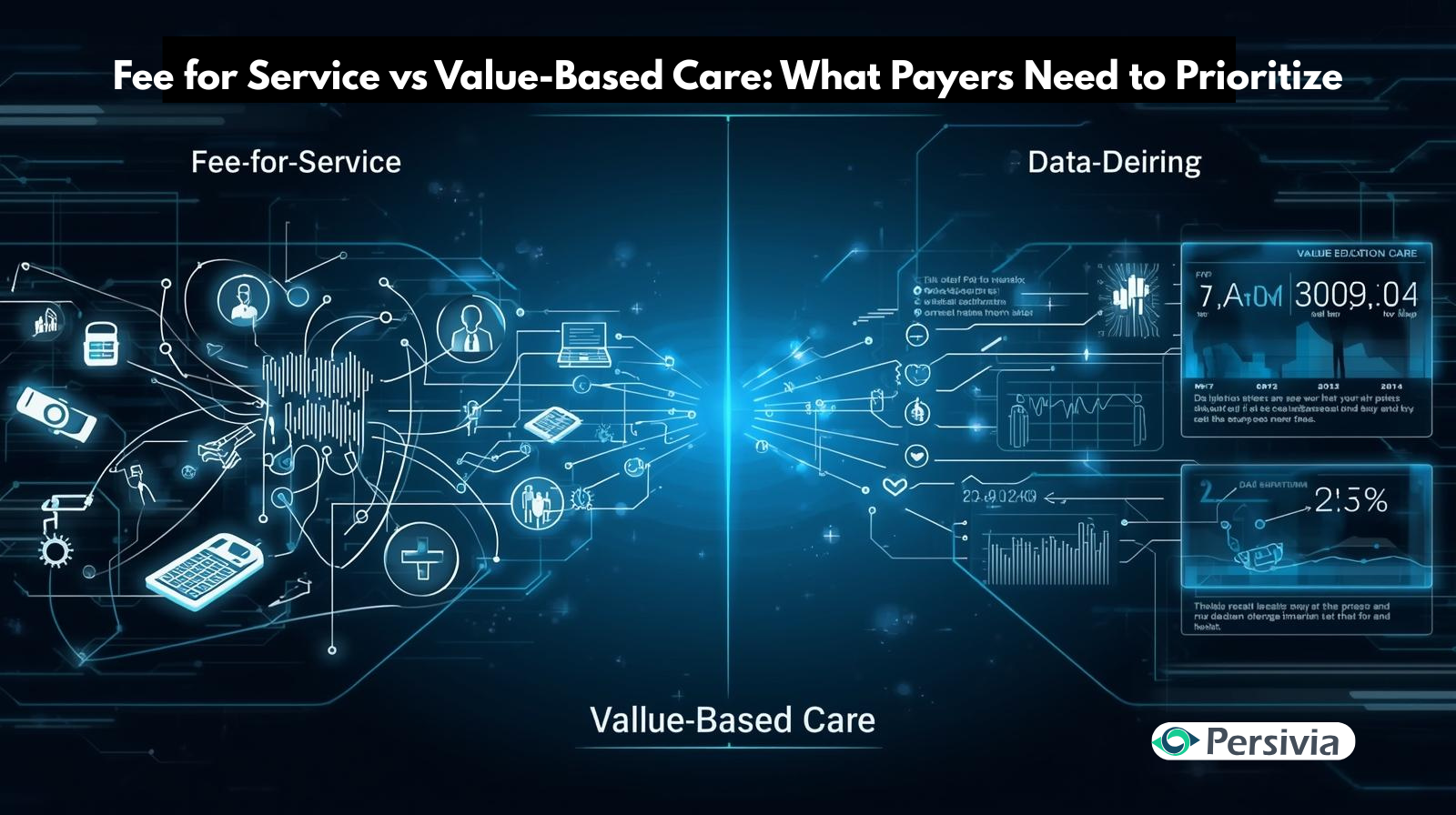Healthcare payers today face a defining choice between two payment models — the traditional fee-for-service (FFS) system and the modern value-based care (VBC) approach. In the FFS model, providers are reimbursed per service or procedure, regardless of the health outcome. In contrast, VBC rewards providers for achieving positive patient results, emphasizing prevention, care coordination, and measurable improvements.
As healthcare payments evolve, payers must carefully evaluate how their payment models influence both financial sustainability and patient outcomes. The debate between fee-for-service vs value-based care has reached a turning point, forcing payers to choose between maintaining short-term cost control or investing in long-term population health improvement.
Understanding Healthcare Payment Models
Two main frameworks dominate healthcare payment systems: Fee-for-Service (FFS) and Value-Based Care (VBC).
-
Fee-for-Service rewards volume — each test, visit, or procedure generates payment.
-
Value-Based Care rewards quality — compensation is linked to patient outcomes and satisfaction.
-
Risk distribution differs as well: under FFS, payers carry most financial risk, while VBC introduces shared accountability between providers and payers.
Fee-for-Service: The Traditional Model
The fee-for-service model compensates healthcare providers for every service rendered — each consultation, test, or surgery generates a separate claim. This model operates like a retail transaction where each service has a price, and providers are paid regardless of whether the treatment improves patient health.
Key Characteristics
-
Individual billing for each medical service
-
Immediate payment after service delivery
-
Provider income tied to service volume
-
Minimal financial risk for providers
Advantages for Payers
Fee-for-service remains common because of its simplicity and transparency.
-
Clear pricing: Each service has a defined cost, making budget planning easier.
-
Broad provider participation: Guaranteed payments attract more healthcare professionals.
-
Administrative ease: Standardized billing codes simplify claims processing.
-
Short-term cost control: Payers can restrict coverage for expensive services.
Challenges and Drawbacks
Despite its simplicity, fee-for-service drives higher costs and fragmented care.
-
Overutilization: More procedures mean higher revenue, encouraging unnecessary services.
-
Escalating costs: Increased testing and treatment inflate healthcare expenses.
-
Limited prevention: Wellness and preventive services generate less income.
-
Poor coordination: Providers work independently, leading to care fragmentation.
This system often prioritizes quantity over quality, resulting in inefficiency and rising payer expenditures.
Value-Based Care: The Modern Approach
Value-Based Care shifts the focus from volume to value — paying providers for delivering measurable improvements in patient health. Under this model, reimbursement is tied to performance indicators like quality metrics, patient satisfaction, and improved outcomes.
Core Components of Value-Based Care
-
Outcome-based payments tied to measurable results
-
Quality metrics evaluating effectiveness and patient experience
-
Shared financial risk between payers and providers
-
Integrated care coordination across specialties
-
Data-driven performance tracking and reporting
Benefits for Payers
Value-based care aligns the interests of payers and providers toward better outcomes and cost efficiency.
-
Cost reduction: Preventive care and reduced hospitalizations lower overall expenses.
-
Improved outcomes: Providers focus on long-term wellness and chronic disease management.
-
Better coordination: Care teams collaborate to avoid duplication and errors.
-
Higher satisfaction: Patient experience becomes a key component of reimbursement.
-
Prevention focus: Early intervention minimizes expensive emergency treatments.
Implementation Challenges
Transitioning to value-based care demands significant structural and technological changes.
-
Complex contract negotiations to define quality metrics
-
Upfront investments in analytics and IT systems
-
Provider hesitation due to financial risk
-
Difficulty in attributing outcomes to specific providers
-
Delayed realization of financial benefits
Direct Comparison: Fee-for-Service vs Value-Based Care
| Aspect | Fee-for-Service | Value-Based Care |
|---|---|---|
| Payment Basis | Volume of services | Patient outcomes |
| Provider Risk | Minimal | Shared financial risk |
| Care Focus | Individual procedures | Comprehensive patient health |
| Cost Control | Limited incentives | Strong cost reduction |
| Care Coordination | Fragmented | Integrated and collaborative |
| Patient Satisfaction | Not incentivized | Directly tied to payment |
| Preventive Care | Low priority | Central focus |
| Long-Term Costs | Tends to increase | Designed to decrease |
This comparison illustrates how value-based care aligns financial incentives with better patient results and long-term system sustainability.
What Payers Should Prioritize
For payers, the transition to value-based care is not just a policy shift — it’s a strategic transformation. Success requires a structured approach that balances short-term stability with long-term performance gains.
1. Assess Current Position
Payers should begin with a detailed evaluation of their current payment models and healthcare delivery outcomes.
Key steps include:
-
Reviewing cost trends over recent years
-
Measuring hospital readmission and emergency utilization rates
-
Evaluating preventive care participation
-
Assessing provider performance and patient satisfaction scores
-
Calculating administrative costs associated with claims management
This assessment helps identify areas where value-based practices can yield immediate benefits.
2. Define Strategic Implementation Priorities
The shift to value-based care should be gradual, starting with high-impact initiatives.
Top priorities:
-
Introduce outcome-based contracts for chronic disease management
-
Emphasize preventive care to lower long-term costs
-
Target high-cost, high-volume procedures for reform
-
Build analytics systems for provider and patient outcome tracking
-
Train providers to adapt to new compensation structures
Technology and Infrastructure Requirements
Successful value-based care depends heavily on data integration and analytics. Payers must adopt advanced digital health platforms that can monitor outcomes, track claims, and evaluate provider performance in real time.
Essential technology capabilities include:
-
Real-time claims processing and payment automation
-
Clinical data integration for accurate outcome tracking
-
Provider dashboards with performance scorecards
-
Patient satisfaction monitoring systems
-
Predictive analytics for cost and quality optimization
Investing in digital platforms not only improves transparency but also enables continuous performance improvement across provider networks.
Financial and Population Considerations
Financial Perspective
While value-based care promises long-term savings, it often requires significant initial investment. Payers must evaluate the financial trade-offs carefully.
Key factors:
-
Technology and data infrastructure costs
-
Legal and administrative expenses for new contracts
-
Risk management strategies for shared accountability
-
Timelines for return on investment
A clear understanding of financial exposure and performance benchmarks helps payers manage transition risks effectively.
Population Health Factors
Not all populations respond equally to the same payment models. Payers should tailor their approach to the needs and characteristics of their covered members.
Considerations include:
-
Prevalence of chronic diseases
-
Accessibility of provider networks
-
Age demographics and utilization patterns
-
Socioeconomic factors influencing care compliance
-
Regional variations in healthcare costs
A targeted payment strategy based on population insights ensures greater impact and efficiency.
The Right Choice for the Future
Choosing between fee-for-service and value-based care goes beyond simple cost management — it defines the payer’s role in shaping the future of healthcare. While FFS provides short-term predictability, it perpetuates inefficiency and overuse. In contrast, value-based care fosters accountability, sustainability, and better patient outcomes.
The transition will require persistence, collaboration, and investment in technology and data systems. However, payers that lead this transformation will achieve:
-
Reduced long-term costs
-
Improved quality of care
-
Stronger provider partnerships
-
Greater patient trust and satisfaction
Conclusion
The move from fee-for-service to value-based care marks a fundamental shift toward outcome-driven, sustainable healthcare. Payers that embrace this change will not only control costs but also elevate patient care standards and long-term health outcomes.
Persivia supports payers in this transformation with advanced, cloud-based healthcare technology. Its intelligent platform integrates analytics, provider performance tracking, and outcome measurement to simplify the transition to value-driven models. By harmonizing financial, clinical, and operational goals, Persivia helps payers reduce administrative costs, enhance patient outcomes, and build resilient, value-focused healthcare systems.




Leave a Reply